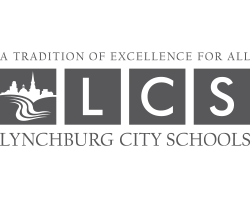“Connection is secure.” When the three words appeared on Heritage High School 12th grader Savannah Hicks’ laptop screen, the room erupted into celebration. Hicks had just successfully set up a secure web server and hosted a website on it—a feat she and a team of three other students had been working toward for the past five months.
Setting up a secure web server with end-to-end encryption to ensure data privacy is an advanced endeavor. Normally left to the highest-level cybersecurity scholars and professionals, it’s not something you’d typically see in a high school classroom.
“I’ve been looking at what other schools are doing projects like this, and the closest I’ve been able to find is master’s-level programming. You don’t get this in other schools,” said Lynchburg City Schools (LCS) Director of Information Technology John Collins, who consulted on the project.

But Hicks’ Advanced Cybersecurity teacher, Bill Carter, knew his students were up to the challenge. They didn’t have to do it alone, either—in addition to Collins’ and Carter’s guidance, students had the expertise of engineers from CloudFit, who worked directly with students to help push the project toward the finish line.
“When Mr. Carter told me he thought I should be on the server team, I was confused because it seemed like such an advanced project. I didn’t know if I was prepared. But now I’ve done it, and it’s been a really cool experience. I’m super excited and happy to have achieved this,” Hicks said.
The Challenge Begins
In January, Carter dreamed up a venture that would put the skills of his most proficient students to the test. One question prompted it all: “What if our classroom could run all its own web services?”
“I asked myself, ‘How can we make our classroom more automated, self-sufficient, and advanced? I started to think about the potential we could unlock if our classroom had its own server,” Carter said. “We’d be able to use it for years to come. It would create so many opportunities for future student projects. And in four or five years, when the server would need to be rebuilt, another group of students would get to work on it.”
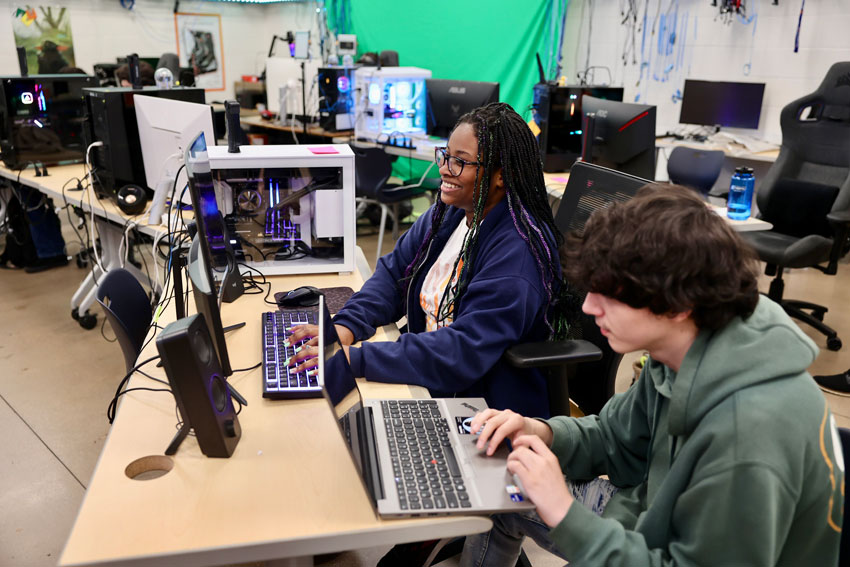
He envisioned a classroom less reliant on external cloud storage, web hosting, and data encryption. Cybersecurity professionals could set up everything from scratch…so why couldn’t Carter’s students? If they could pull this off, future students could build off their work, creating industry-standard systems that could be improved upon and updated to keep up with evolving technology.
Carter assembled a team of his most advanced students. He recruited Hicks and Heritage High 12th grader Kiah Ford from his Advanced Cybersecurity class. E. C. Glass High School 12th grader DreShad “Shad” Browley and Heritage High 10th grader Gabe Harris joined the team from Carter’s Computer Systems Tech class.

From left to right: LCS students Savannah Hicks, Shad Browley, Kiah Ford, and Gabe Harris.
From Screws to Success
To host a secure web server, the team would need to start from literal nuts and bolts. They built a physical machine from scratch, then set out to achieve three goals.
The first was to create a file storage and retrieval system that would function as the classroom’s own version of iCloud or Google Cloud. The second was to set up a functioning web service for the classroom—the students chose a discussion forum. The third was to create the secure web server and host a website on it.
The project aimed to help these four students develop high-level cybersecurity skills through hands-on learning and to set up systems that would enrich cybersecurity education at Lynchburg City Schools (LCS) for years to come.
“The project began to build momentum and gain a life of its own. We started out with a concept, and the students took it and ran with it. They’d get passes to come to my classroom during study hall, ask me for more assignments, and run ideas by me,” Carter said. “They dug deep—and in some cases, they were ahead of me.”

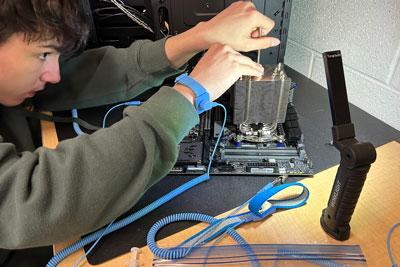
Goal 1: Creating a Cloud
As they began working to make their vision a reality, the team quickly found their groove. Each student carved out a niche for themselves, contributing their unique skills and interests.
Harris and Browley took charge of the hardware. With Ford’s help, they worked together to build the machine from which the rest of the project would operate. Harris set up disc drives, connected the hardware with the software, and configured SAMBA, a file services software. Together, they achieved the first goal of establishing a cloud file storage and retrieval system.
“I’ve never worked on something like this before. I like building things with my hands, but this was a first,” Browley said. “We didn’t know what we were doing, but we learned together.”

The students were venturing into uncharted waters; no one in Carter’s classes had attempted something so ambitious before. They learned as they went, referring to Chat GPT 4.0 for coding and troubleshooting help.
“There was a lot of trial and error involved. It was stressful and painful when we hit obstacles, but it was worth it. I wouldn’t get the opportunity to do this anywhere else—you don’t go to school and expect to build a server,” Harris said. “I’m walking away with a better understanding of coding."
The process could be frustrating, but Harris and his team weren’t alone. They talked through solutions with Carter whenever they got stuck. Carter provided guidance and support, but encouraged students to seek solutions independently. This way, their successes would be their own, and the lessons learned along the way would be all the more meaningful.
“If they needed something, I ordered it. If they got stuck troubleshooting, I reviewed what they had done and pointed them in a direction or gave them an idea of what to look for. Many Sundays were spent in my own analysis,” Carter said. “I was careful not to step in, touch the keyboard, or hand them the solution.”
When thinking through how to get the server off the ground, they also enlisted the help of LCS Director of IT John Collins. He recommended the Linux operating systems and Proxmox virtualization platform, which Ford and Harris worked to implement.

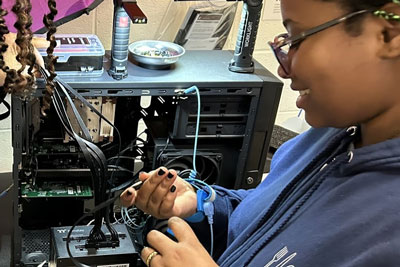
In addition to setting up Linux and Proxmox, Ford acted as a project coordinator, taking notes and ensuring the group stayed on task. She worked with Hicks and Carter to document the group’s progress using a Google Site.
“It’s been a fun and cool learning experience. It taught me to work with people better; I’m sort of a people person, and I used some of my organizational skills to help improve group cohesion and keep everyone on the same page. I learned a lot of coding through this,” Ford said.
Goal 2: Formulating a Forum
With the foundations laid, Hicks and Ford got to work building an open-source, cloud-based community discussion forum for the class to use. The website went live in March, accomplishing the group’s second goal. Students immediately began using the forum to have lighthearted discussions and ask each other coursework-related questions.
“It was a big moment for the class,” Carter recalled.
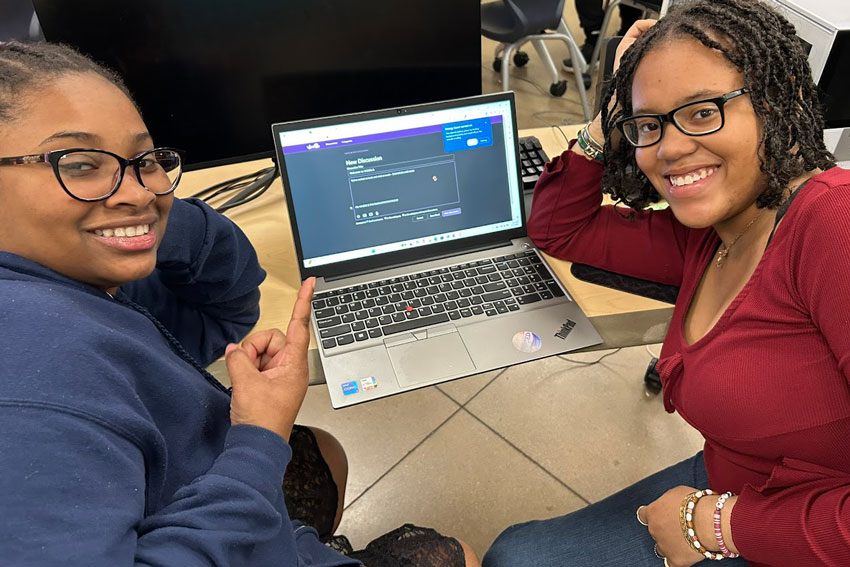
Goal 3: Securing the Server
The first two goals had been accomplished. Hicks set out to achieve the final goal: creating a secure server. This task would require specialized expertise. Who better for the job than engineers from local tech company CloudFit Software?
“I viewed inviting CloudFit as bringing in an external resource for the student team at a critical juncture where deeper expertise was needed. The CloudFit systems engineers understood this dynamic well. They offered direct solutions and insights, but they kept Savannah on the keyboard, allowing her to learn by doing,” Carter said.

CloudFit engineers visited Carter’s classroom twice during the final stretch of the project in May. They shared their knowledge of secure servers with the Advanced Cybersecurity class, then worked directly with Hicks to set up the secure server and host a website on it. CloudFit engineer Jack Tidball helped Hicks encrypt website traffic, validate the domain, and resolve backend certificate and trust issues.
Finally, the three magic words popped up on Hicks’ screen: “Connection is secure.” Hicks and her teammates were ecstatic. They’d finally achieved their third and final goal.
“It was an out-of-body experience,” Hicks reflected.
To start, the website was bare-bones—just a blank webpage. Over the final few weeks of school, they made it into a functional class forum site, like the one Hicks and Ford had developed previously.
“Seeing their progress and the hurdles they’d already overcome, I wasn’t surprised by their ability to secure the server. What these students have achieved is impressive,” Tidball said. “As one of the few software companies in the area, CloudFit has the unique opportunity to pour into local schools and mentor computer science students. I’m grateful for the chance to share my expertise.”
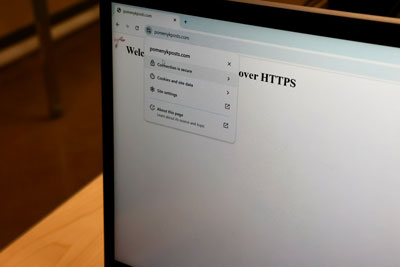

Show Me the Pasta
For Hicks, Ford, Browley, and Harris, this final victory came with a long-anticipated reward. For months, one mantra had sustained them through late nights spent troubleshooting and class periods consumed by frustrating setbacks: “Show me the pasta.”
Carter had promised them a meal at Olive Garden as a treat for accomplishing all three goals. In June, the team dined with Tidball, Collins, and LCS Director of Career and Technical Education (CTE) Robbie Dooley. As they tucked into plates of pasta, the group reflected on what they’d achieved.
“This wasn’t just a classroom project. It reached outside into the community, as well. It’s amazing that our IT department and CloudFit, the most cutting-edge software company in Lynchburg, played integral roles in this,” Dooley said. “These students got to work directly with industry professionals to accomplish something truly impressive—an opportunity they’ll remember for a lifetime.”
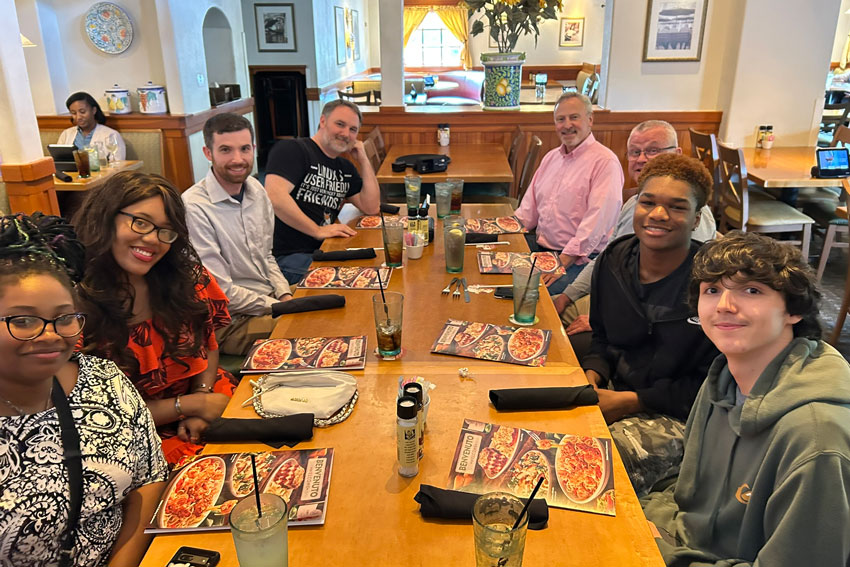
Their victory lap at Olive Garden represented the end of this chapter and the beginning of the next. Three of the four students graduated from high school in June. Hicks will study computer science at Randolph University as the first-ever recipient of the LCS Computer Science Scholarship. Browley plans to study computer engineering at Old Dominion University, and Ford plans to study marine biology after pursuing an associate’s degree at Central Virginia Community College. Harris will continue to explore cybersecurity, no doubt taking on more advanced projects during his final two years at Heritage High.
But even after the original group of four has moved on, their work will impact cybersecurity students for years to come. The server, discussion forum, and cloud system open up countless possibilities for advanced student projects, tangibly enriching the LCS computer science program.
Carter is already planning student projects that will build on their work. Starting in the fall, his students’ next challenge will be to build a ticketing system for technical class assignments on the server. This will mirror the type of structure IT professionals use in the real world to keep track of tasks and requests.
“Anytime we can prepare our students for the future with real-world experiences that mimic what they’d see in a professional setting, we’re setting them up for success,” Collins said.
For Hicks, this impact on future students is the most exciting thing about the project. She and her teammates will remember it as their legacy at LCS.
“The coolest part is knowing that years from now, other students will be using this server. They’ll be able to constantly build on the work we’ve done,” Hicks said. “This has been such an amazing opportunity, and I’m proud to play a part in enriching the program for students even after I’ve graduated.”


